This site uses cookies. View our Cookie Policy to learn more about how and why.
This site uses cookies. View our Cookie Policy to learn more about how and why.
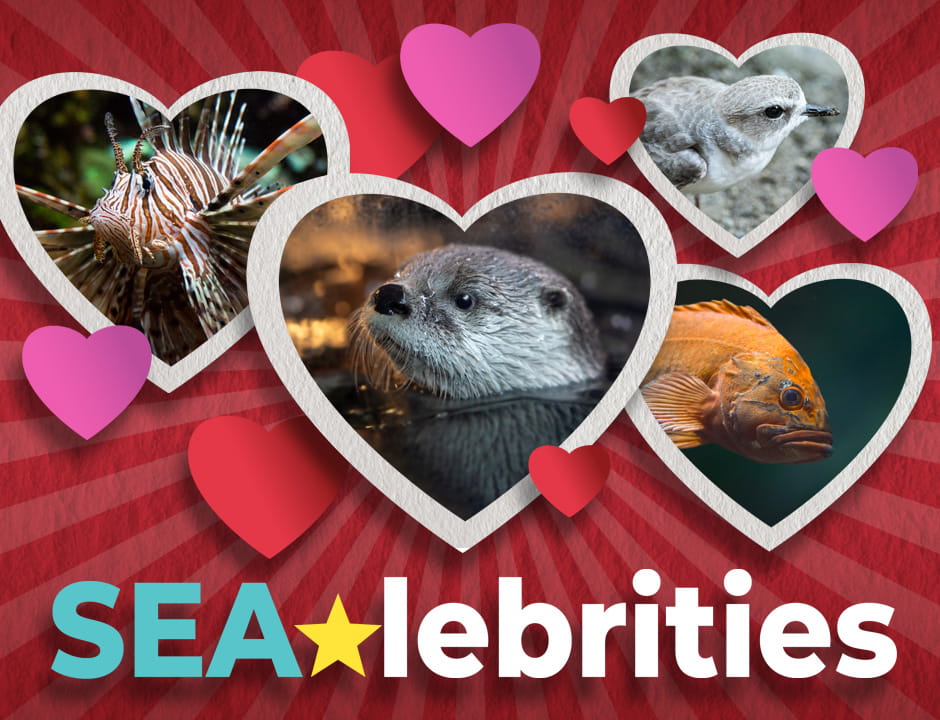
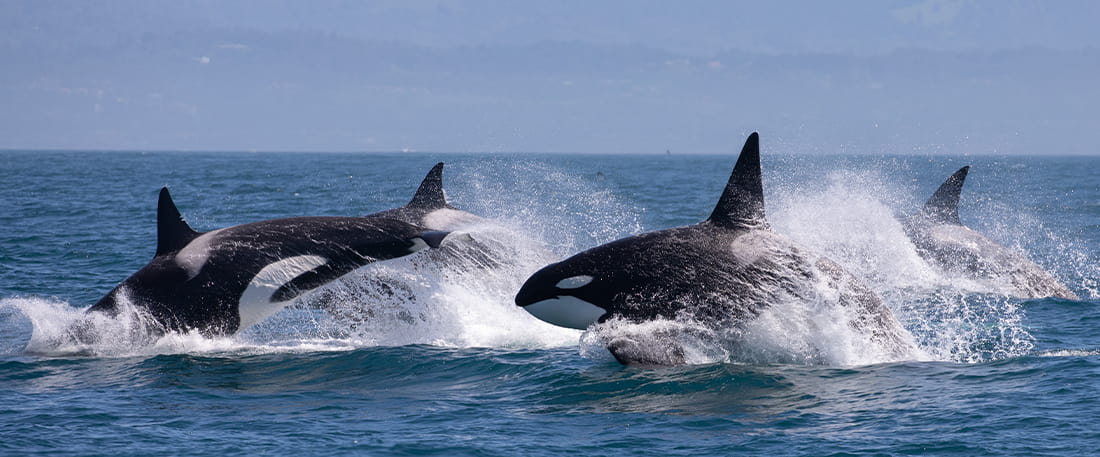
From late October to early January—for the first time—many large ships in Washington waters slowed down for orcas.
How does this help whales? Slower vessels make less noise. When the waters are quieter, endangered Southern Resident orcas have an easier time communicating with each other and echolocating to find and catch scarce salmon. Slow-moving vessels are also less likely to hit a whale, and as a bonus for the climate, the ships’ greenhouse gas emissions decrease.
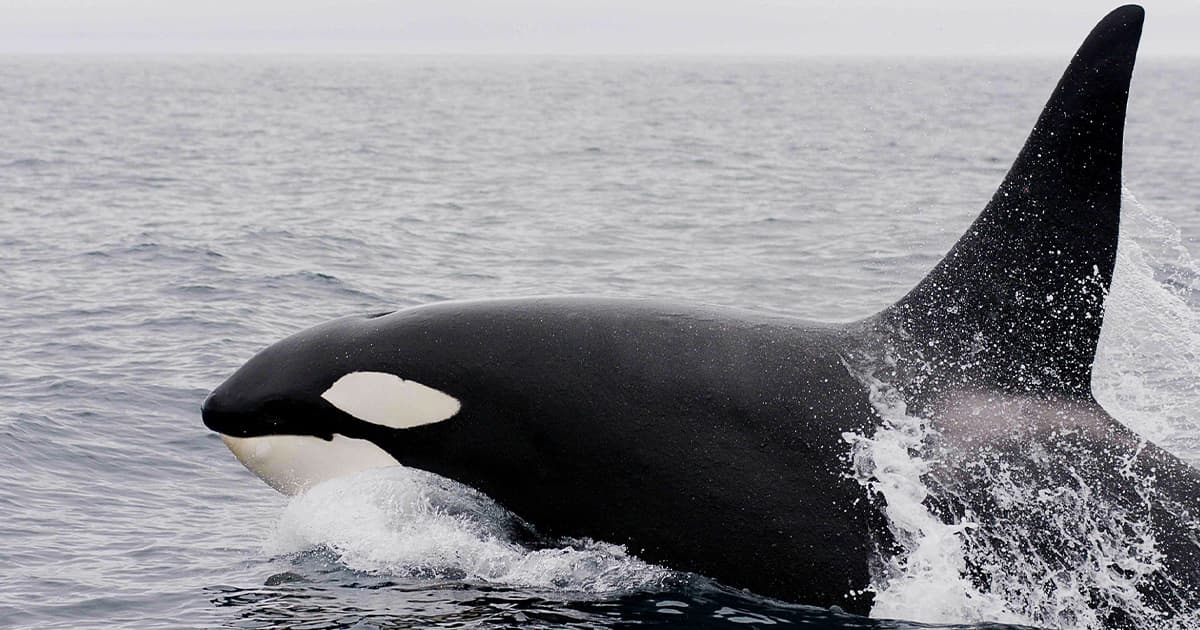
The voluntary ship slowdown was made possible by a new program called Quiet Sound—a collaborative effort involving government agencies, the shipping industry, the U.S. military, tribal groups, environmental organizations like the Seattle Aquarium and the scientific community—and modeled after a successful program in British Columbia, Canada. The Washington waters trial encouraged vessel operators to reduce their speed in designated transit areas to targets of 11 or 14.5 knots, depending on vessel type. The result? Twenty nautical miles of a quieter, better protected habitat for orcas and other wildlife.
To continue and even expand this work, Quiet Sound needs additional funding from the Washington state legislature. This legislative session, the Seattle Aquarium is supporting a $700,000 two-year request in Olympia to do just that.
But large ships are just one source of underwater noise. This legislative session, we also have an opportunity to reduce noise from smaller recreational boats. Senate Bill 5371/ House Bill 1145 reflects the latest science-based recommendations from the Washington Department of Fish and Wildlife to create a 1,000-yard buffer around the endangered orcas for all small boats (except active commercial fishing and tribal fishing boats and permitted research boats). This simplifies currently complex regulations and reflects the latest science from NOAA, showing that a Southern Resident orca’s chance of catching a salmon is dramatically reduced when boats are moving at any speed within 1.5 km (1,640 yards). The bill also reduces the cost of a commercial whale-watching license, and boaters would not see any changes in what is allowed for viewing other whale species. The Seattle Aquarium supports this legislation, and we hope you will raise your voice with us.
For more orca inspiration, check out our short film Stories from the Salish Sea: Eba and the Orcas if you haven’t already! That webpage also has ideas for how you can take action to reduce toxic pollution, which will help increase salmon available for the orcas to eat—vital for their recovery.
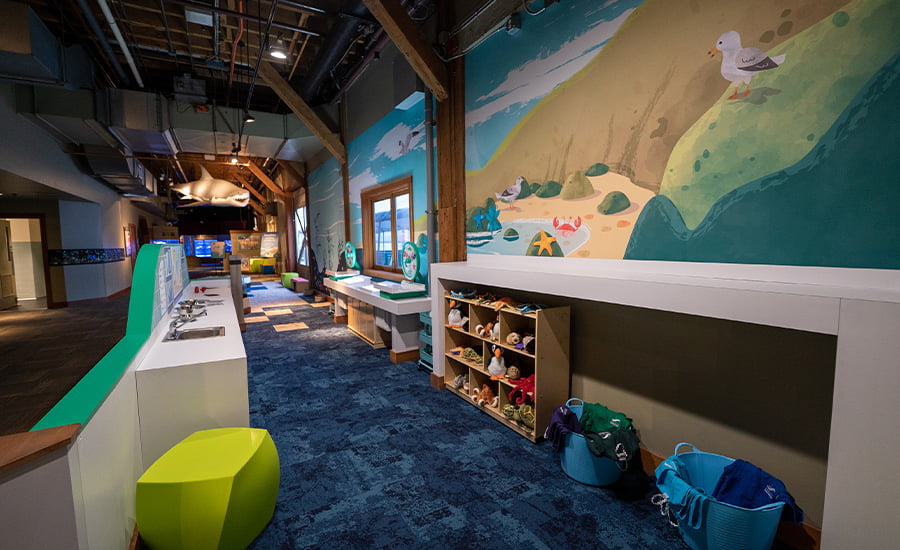

Looking for something new and fun to do with young kids on a wet and dreary winter day? Come discover Caring Cove, an open play space where kids can deepen their connections to marine animals and their habitats by play-acting a variety of animal care activities.
Caring Cove, which opened on January 15, features six different areas—many stocked with toy instruments based on the equipment used by our animal care staff—that encourage and support imaginative play for toddlers through children ages 8–10:
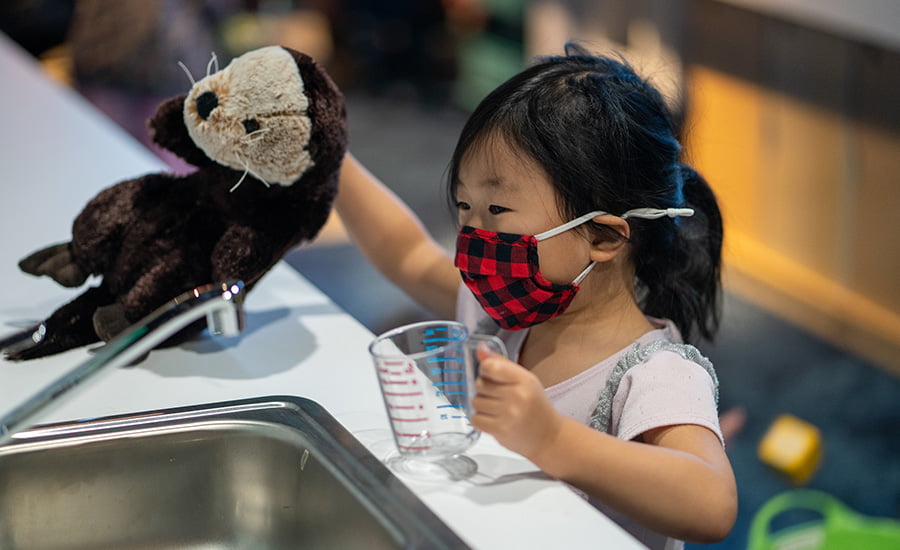
Caring Cove also features a reading area stocked with children’s books for parents and caregivers to read aloud or for kids to page through on their own; and benches for reading or resting while the kids play.
Whether kids pretend to be an aquarist, an animal care specialist, a veterinarian, a diver, an interpreter or a role they create with their own imagination, they’re sure to have a wonderful time. Parents and caregivers too! “The whole area is for families,” says Interpretation Coordinator and Scientific Diver Nicole Killebrew, who served as the project manager for Caring Cove.

The vision for Caring Cove began with a desire for an early childhood play space to support our empathy work, which is funded through a grant from an anonymous donor. Empathy is defined as the ability to understand and share the feelings of another—and research has shown that empathy for animals, particularly in children, can help spur conservation action on the animals’ behalf. “The interconnectedness between empathy and conservation action is inextricable,” says Nicole. “And now we have an imaginative play space where young kids can connect to marine animals that they may not even know are living things—like a sea star—and understand that they have the same needs for food, a home, nurturing and care,” she adds. “We’ve never had anything like it.”
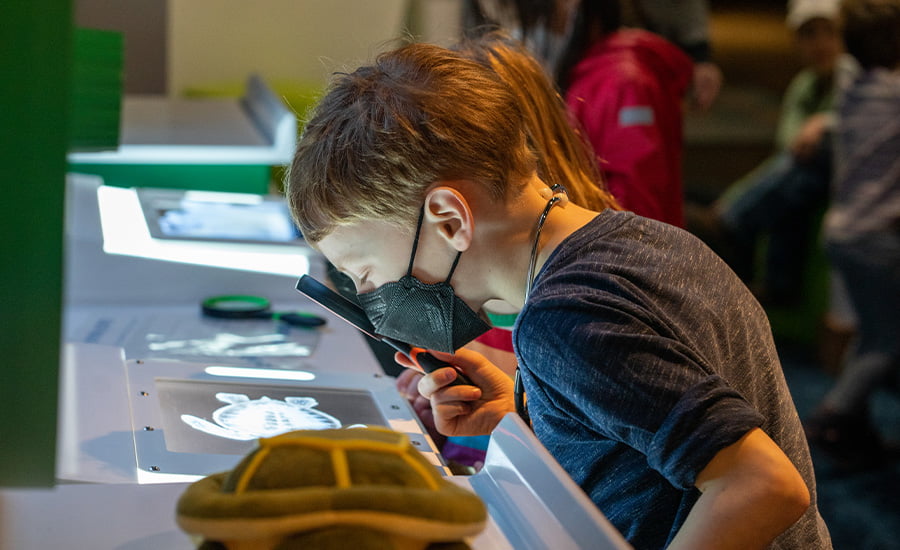
Special and immense thanks go to local business Dillon Works, who designed and fabricated Caring Cove; the Advancing Conservation through Empathy for Wildlife Network, which provided critical project funding; the anonymous donor who funds our empathy grant; and the dozens upon dozens of Aquarium staff members who contributed their time and expertise to the project. “It was truly an Aquarium-wide effort,” smiles Nicole.
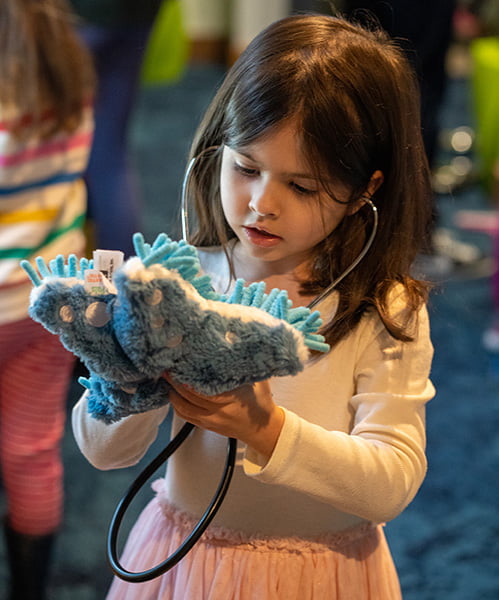
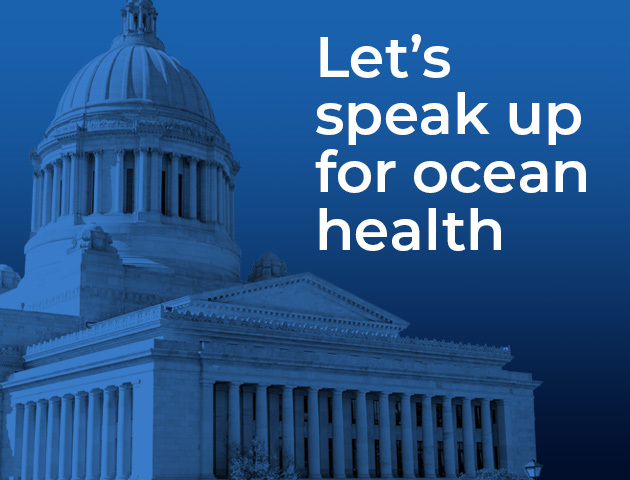
As the Washington state legislative session begins, the Seattle Aquarium is working with partners to advance science-based policies and funding that will protect ocean health. Read on to learn about some of our top priorities for 2023—and how you can take action, too!
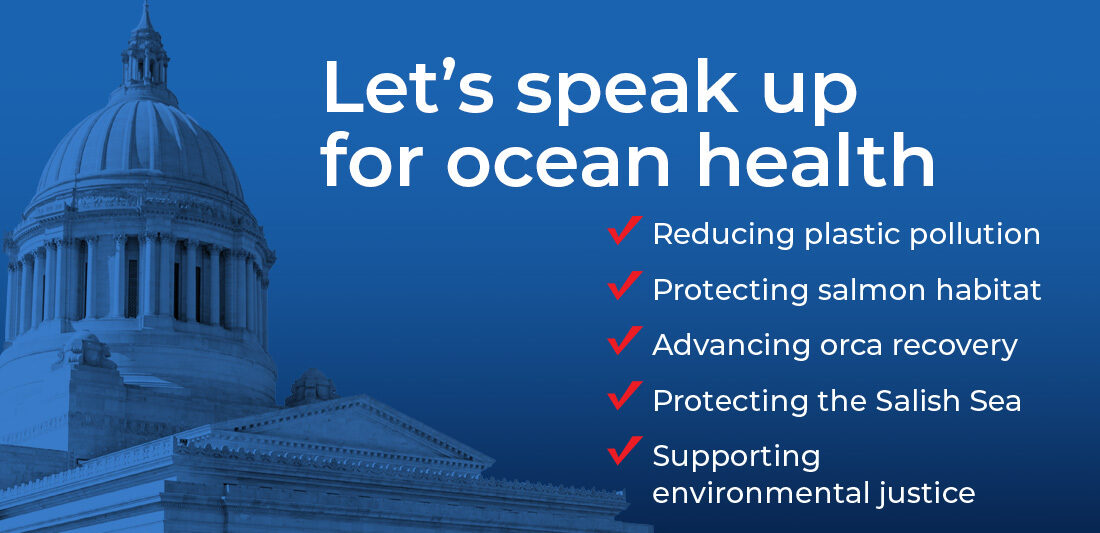
Waste, including harmful plastics, accumulates in the ocean and on our shorelines, putting marine wildlife at risk. Single-use packaging represents a particularly significant environmental problem—very little of it is recycled. Packaging producers are best placed to change that by switching to readily available alternatives. We are advocating for bills that will incentivize producers to make such changes; modernize and transform our recycling system; and reduce sources of plastic pollution and waste.
The Washington Recycling and Packaging (WRAP) Act (SB 5154/HB 1131) will:
HB 1085 will:
We are also supporting a bill called Right to Repair, which would enable small businesses to repair personal electronic devices like cell phones so people can keep using them instead of buying new ones. This will help limit the need for new materials that may be sourced through harmful practices like seabed mining.
Salmon are keystone species and critical for Washington ecosystems and communities, as well as for the survival of the endangered southern resident orcas. We are supporting several policies and budget items to recover salmon and protect their habitat, including:
This small population of orcas is at risk due to lack of prey, pollution and disturbance from vessels. To help ensure the recovery of this iconic and important species, we are supporting:
We are supporting WDFW’s $47.6M Restoring Washington’s Biodiversity funding package, including $850,000 per biennium to support pinto abalone recovery.
As a member of the Environmental Priorities Coalition (EPC), we also support the other EPC and Partnership Agenda items including investing Climate Commitment Act revenue strategically and equitably and requiring local governments to incorporate climate resilience into comprehensive plans (HB 1181/SB 5203).
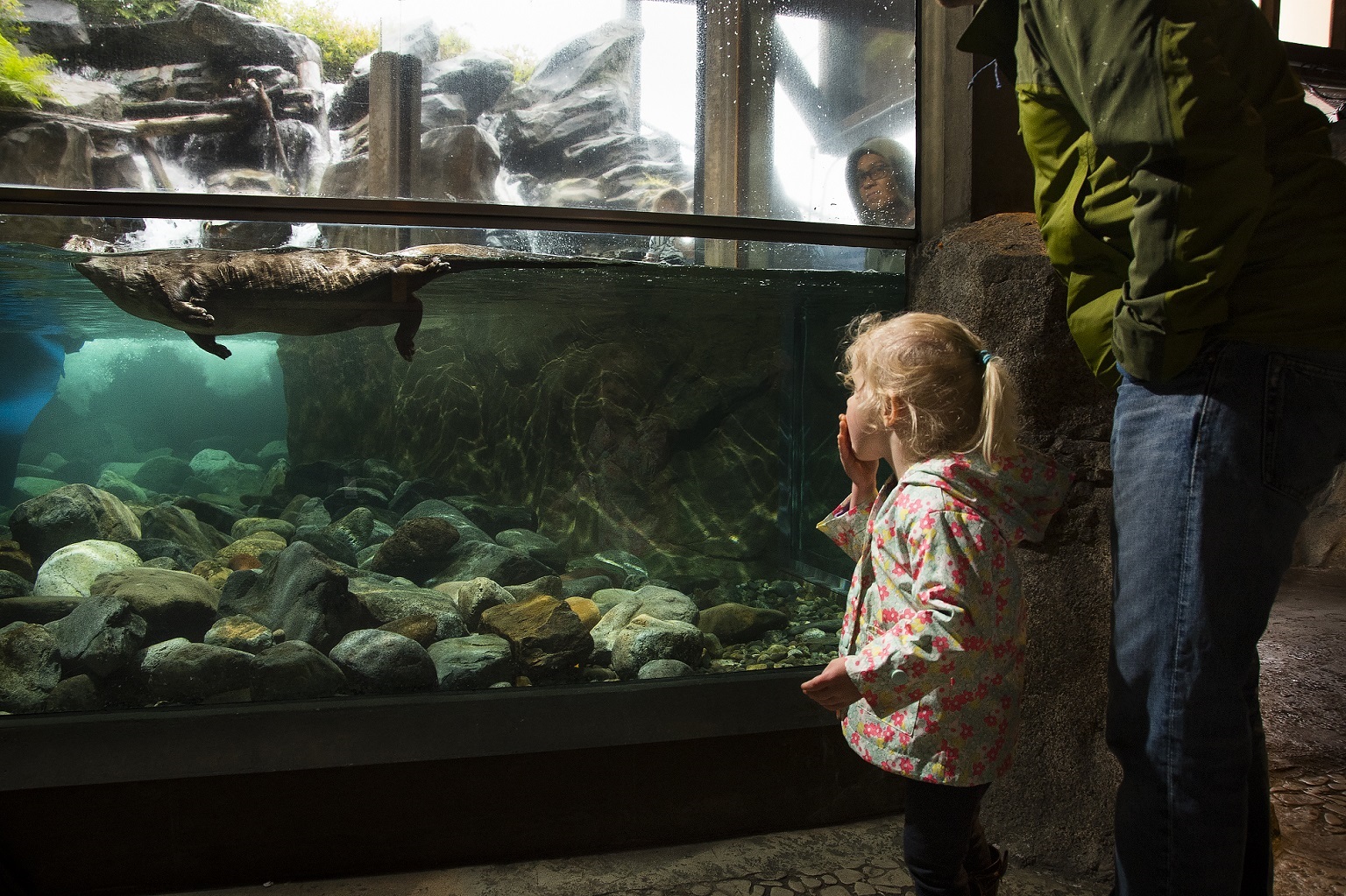
This concludes our series of blog posts devoted to some of the amazing people who volunteer for the Seattle Aquarium. Interested in becoming a volunteer yourself? Scroll to the bottom for details!
Jean Brosell’s interest in the ocean began in 1979 when she took a marine biology college course she needed to graduate.
“The experience was so amazing that every vacation after that for the next 20+ years was to somewhere I could go diving,” she recalls.
As an evening event volunteer at the Aquarium, Jean shares her enthusiasm for marine life with guests at weddings, corporate events and even portions of the summer festival Seafair. Often, the people she meets are seeing the Aquarium for the first time—and Jean gets to share in their excitement and delight.
Stationed in the Life on the Edge habitat, she might show guests the newest giant Pacific octopus, point out fish eggs in one of the tide pools, demonstrate how to gently stroke a sea cucumber or explain the Salish Sea’s unique and delicate ecosystem.
“I love the ‘aha’ moment when the guest who is shy or afraid to touch a sea urchin reaches in and finds that the urchin gives a little hug,” Jean says, “or when you get to talk to a guest about the ever-elusive giant Pacific octopus or the cute northern sea otters, which are my favorite creatures at the Aquarium.”
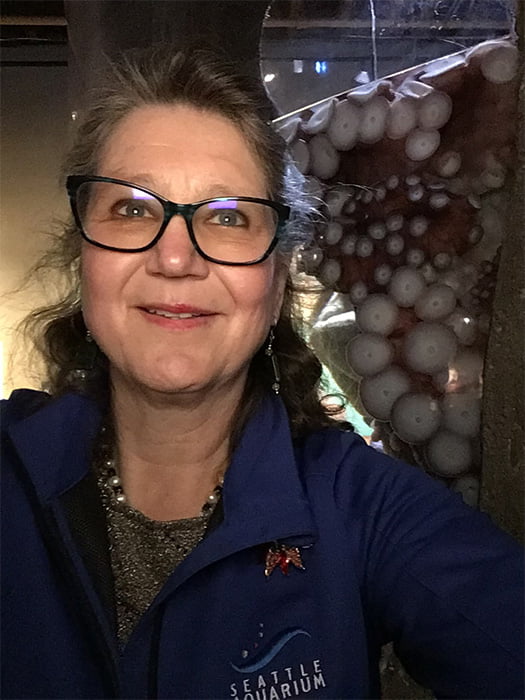
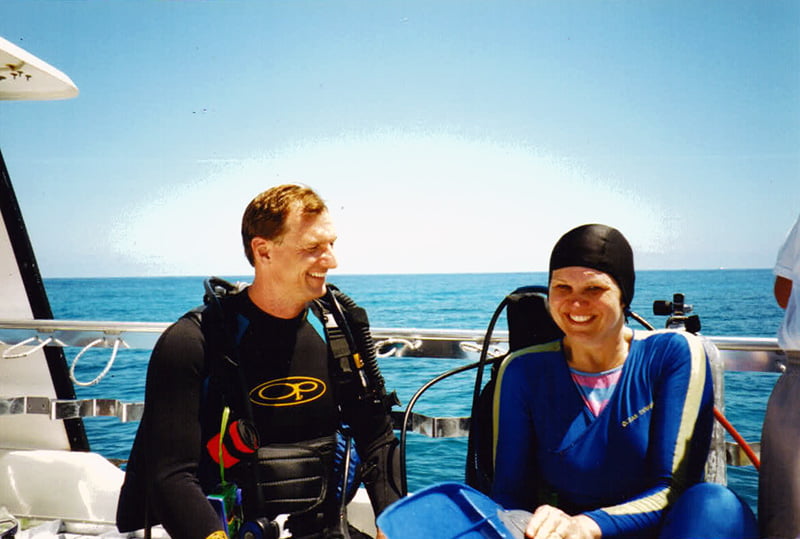
Jean has especially fond members of volunteering during Seafair. After giving a tour to one of the Blue Angels and his fiancé, a former Navy nurse, she received a Blue Angel pin from the couple.
And though Jean didn’t pursue a career in marine biology, she says that the Aquarium’s volunteer training program armed her with the knowledge she needs to feel comfortable on the floor.
“This is my fun volunteer job,” she says. “I thoroughly enjoy getting to interact with guests and helping them to have an enjoyable experience at the Aquarium. It is no stress, no hassle interaction with people from all walks of life—what could be better?”
Ready to join Jean in sharing the Seattle Aquarium’s mission with visitors? Visit our volunteer page to explore volunteer opportunities, including evening opportunities like Jean’s role, and to register for our upcoming volunteer orientation!
Helping guests “glow up:” a surprise perk of volunteering at the aquarium
Volunteer as a diver at the aquarium? “Do it!” says Whitney Golay


Meet the Seattle Aquarium’s latest SEAlebrities: Rock and Roll, the rockfish! They are just two fish out of the 14 different rockfish species found at the Seattle Aquarium. But there are many more types of rockfish in the wild, with 24 species in the Pacific Northwest and more than 100 species worldwide.
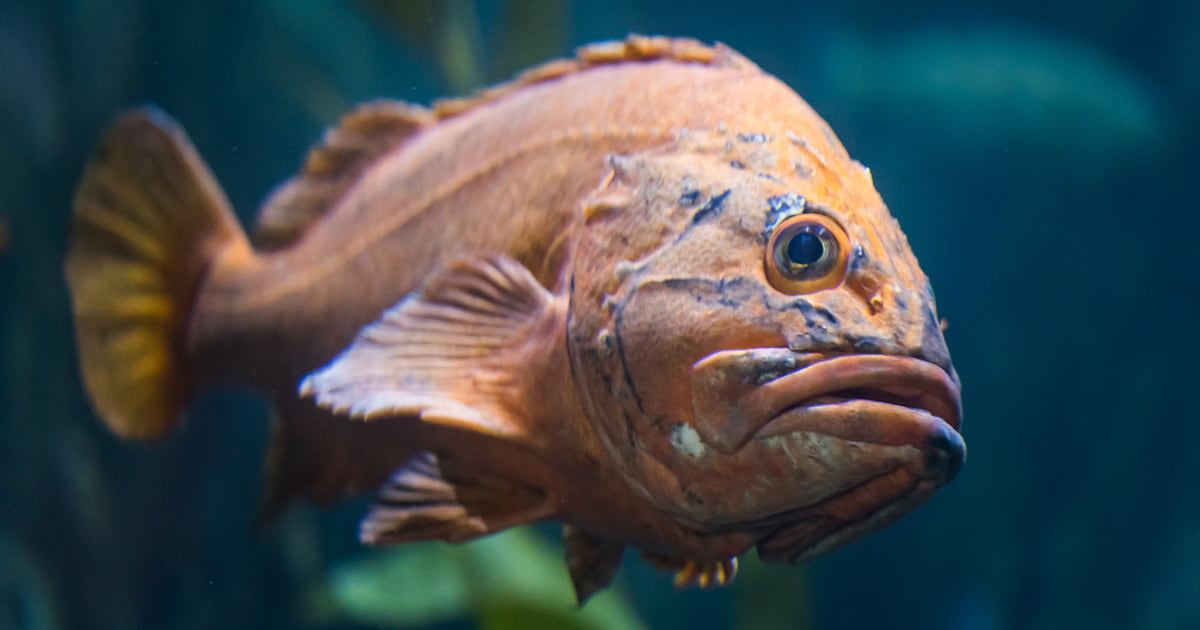
When looking at a rockfish, it’s easy to point out how different they are from humans. But we share a lot more similarities than you might think:
Admit it—getting older can be stressful sometimes. But one similarity humans and rockfish have is the ability to age gracefully. While most other fish have lifespans of two to 10 years, rockfish tend to live very long lives—up to 100 years or more! Unfortunately, there is a downside: Many rockfish who live to be 100 years or older don’t reach sexual maturity until they’re nearly 20 years old. Since they are susceptible to overfishing, some rockfish don’t have a chance to reproduce before they’re caught in a fishing net. That’s why most rockfish are listed as a species to avoid in sustainable seafood consumer guides.
Though all people share common physical characteristics, our appearances vary widely and each of us is unique. Rockfish are the same way. Some species can be as small as 6 inches, while others may be 3 feet long and weigh up to 40 pounds! Rockfish can be red, orange, black or green, or even have a splotched or striped pattern.

Some people love to be social butterflies, while others prefer to go it alone. The same applies to rockfish. Some rockfish species live in schools, with hundreds or even thousands of individual fish! Others live more independent lifestyles and are protective of their solitary homes.
Human diets can range widely, depending on our individual wants and needs. Rockfish are the same way. Their go-to meals include plankton, small crustaceans such as crabs and shrimp, smaller fish like Pacific herring, and even jellyfish and squids!
Humans, fish and every living organism on the planet need a healthy, clean environment to thrive. You can help rockfish and other species by doing your part to protect Puget Sound and the ocean beyond, and choosing seafood from the “Best Choices” and “Good Alternatives” lists on the Seafood Watch cards at the Seattle Aquarium.
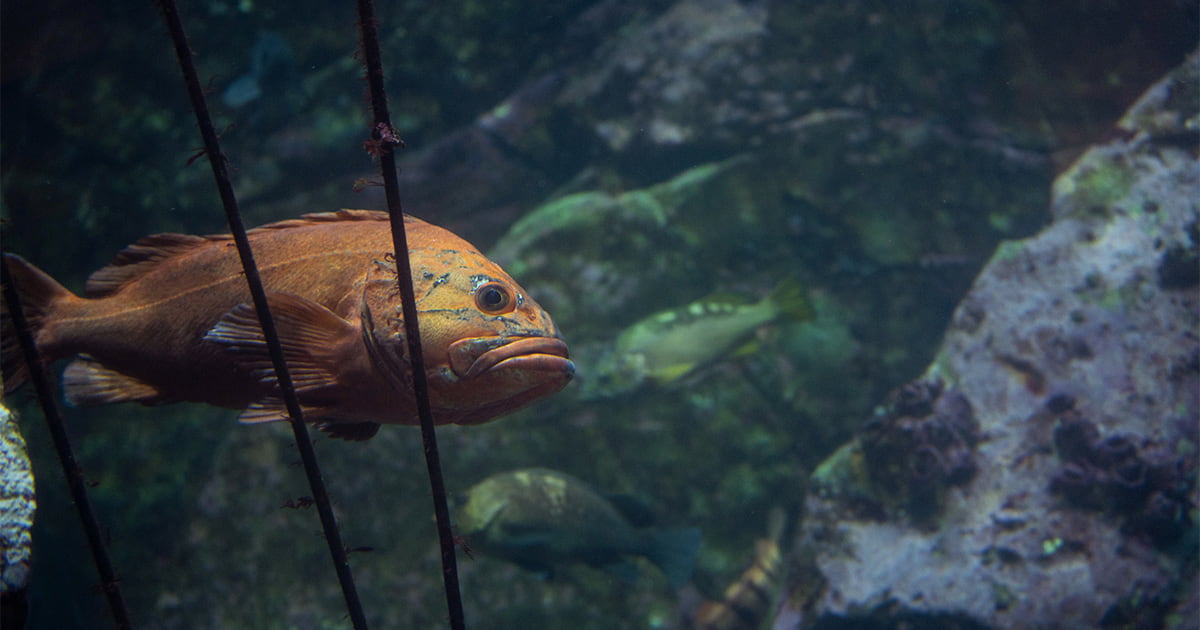


When people hear that Aina Hori grew up in Hawai‘i, invariably they assume she surfs. She chuckles at this fantasy, clarifying that yes, the beach was her playground, and no, she didn’t ride the waves. Nonetheless, she loved the ocean, and her appreciation grew on elementary school outings. “In Hawai‘i, a lot of field trips take you to nearby beaches,” recalls Aina. “They build an understanding of where we live and why we have to take care of our environment.”
It was on these excursions, as she interacted with volunteers, that Aina discovered she wanted to be connected to the sea. Her interest developed as she spent hours exploring tide pools and getting familiar with the ocean. Eventually, when she set off for the University of Washington (UW), unsure of her major, she heeded the wisdom of her parents, who advised her to study something she really enjoyed. Luckily, the UW had just established a new marine biology major, and in June 2022, Aina was among 50 students in the first in-person graduating class. This fall, she’s continuing her studies through the School of Marine and Environmental Affairs at the UW.
Aina heard about volunteering for the Seattle Aquarium from her classmates and decided she’d like applying her schooling to the real world. On her Saturday shifts as a habitat interpreter, she meets many families with children. Remembering how her experience with volunteers impressed her as a kid, she encourages those who are interested, letting them know a career in marine biology is possible.
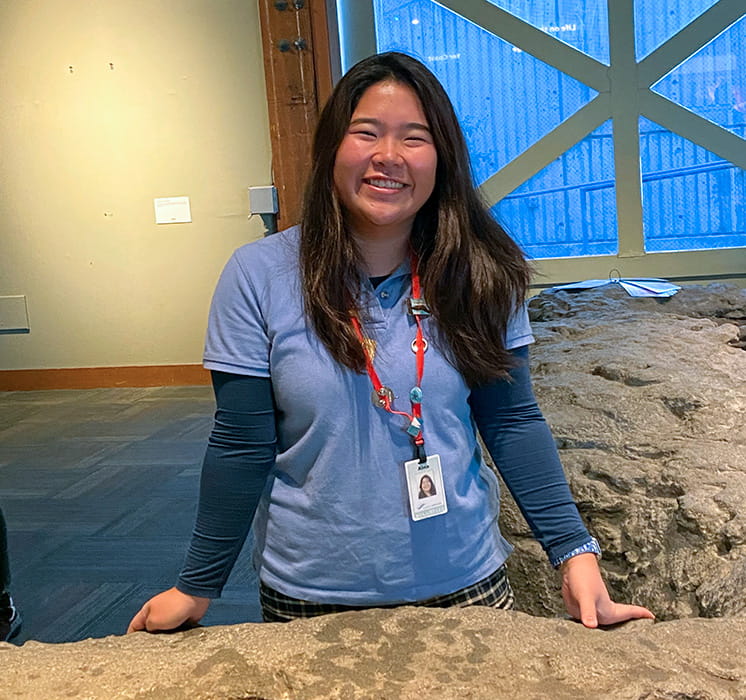
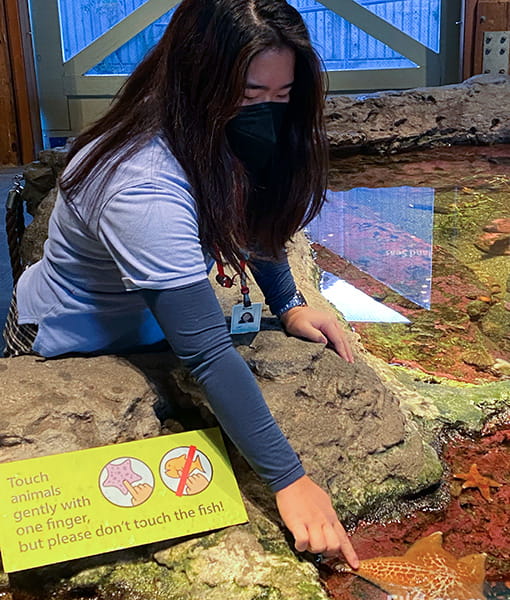
What does she like most about her role? “It’s a pleasure to show visitors who’ve never experienced the Pacific Northwest ecosystem—let alone water because they’re from landlocked areas—that you can get an urchin hug…it has a mouth…it’s an animal…the amount of times that a person’s face ‘glows up’ never gets old!” she says delightedly.
Between graduate school and volunteering, Aina’s calendar is full. But she still makes volunteering at the Aquarium a priority, as she feels that in addition to increasing her aquatic knowledge, it also enhances her life skills, such as interpersonal communication and being at ease with people from all around the world. And she’s built a network of co-workers and supporters who she can rely on, wherever her future takes her.
Aware that balancing school and other responsibilities is challenging, she offers this advice for students contemplating volunteering: “Given the Aquarium’s requirements, if you want to help and are limited on time, let them know you’re interested along with your availability and they’ll work with you to find appropriate opportunities.” There are many prospects, including interpretation at evening events and seasonal needs like the Beach Naturalist and Cedar River Salmon Journey programs—positions that might not conflict with classes and other life obligations.
Aina’s commitment to the Aquarium is clear: she’s given more than 230 hours of service in her three years as a volunteer. One of the key reasons she loves being a habitat interpreter is that she helps visitors realize that each individual can make a difference to our environment. “I keep volunteering because, by sharing, I create a fascination so people care and want to help change the world for the better,” she says.
Ready to join Aina in sharing the Seattle Aquarium’s mission of Inspiring Conservation of Our Marine Environment? Register for our upcoming volunteer orientation today! You’ll find all the details on our volunteer webpage.
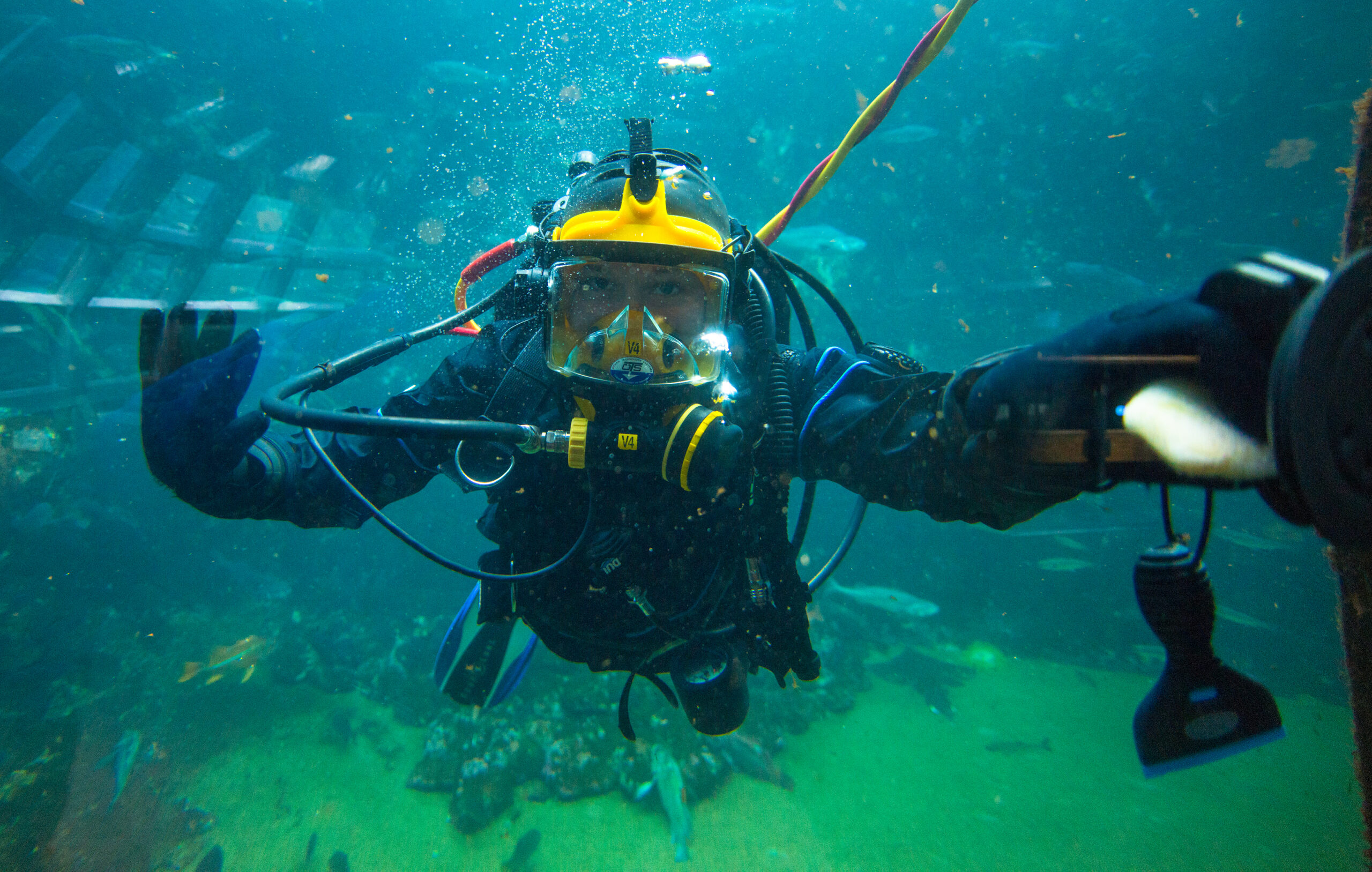
Whitney Golay started volunteering for the Aquarium in 2012 as a beach naturalist. In 2014, she added diving to the mix and, at last count, had logged more than 550 hours of service—all of them in our Pacific Coral Reef habitat. “It’s essentially a mini vacation where I can see tropical fish up close without having to go to Hawai‘i,” she says, “And I’m giving back at the same time.”
But Whitney’s appreciation for the marine environment isn’t limited to tropical waters. She studied marine biology at the University of Washington because of her love of the Salish Sea—a love she shares with her dad. “When I was growing up, my family would spend weekends on the Kitsap Peninsula, checking out all the tide pools and some of my favorite Salish Sea creatures, nudibranchs,” she says.
Whitney’s journey to becoming a diver started in 2010, while she was working in Friday Harbor, analyzing underwater rock wall photos on a computer. When a co-worker signed up for a scuba class, she decided to join. “And, a few months later, I was getting to look at all the underwater sights that I’d been staring at through the computer screen,” she comments. She got her dive masters in 2014 and started volunteering for us the same year.
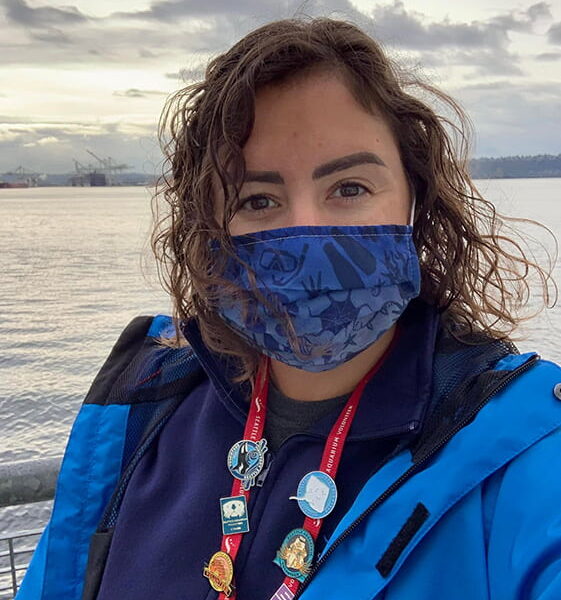

Now, Whitney spends her volunteer shifts diving in the warm-water habitats at the Aquarium, where she feeds the fish, watches the antics of the porcupinefish (one for her favorites), cleans the habitat and waves to guests on the “dry side.” She especially loves waving to young girls, who she hopes are inspired to share her passion for the ocean and conservation.
When asked what she would say to someone who is considering becoming a volunteer diver at the Aquarium, her short answer is, “Do it!” She adds, “It’s a unique opportunity. You’re able to see some of the species up close that you are never going to see otherwise.”
Potential volunteer divers are required to have a minimum of 12 dives in local diving conditions within the last year and an advanced open water diver certificate. Divers must also commit to at least one three-hour shift at the Aquarium, every other week for at least a year. Interested in learning more? Visit the adult volunteer page on our website and fill out our diver experience form!